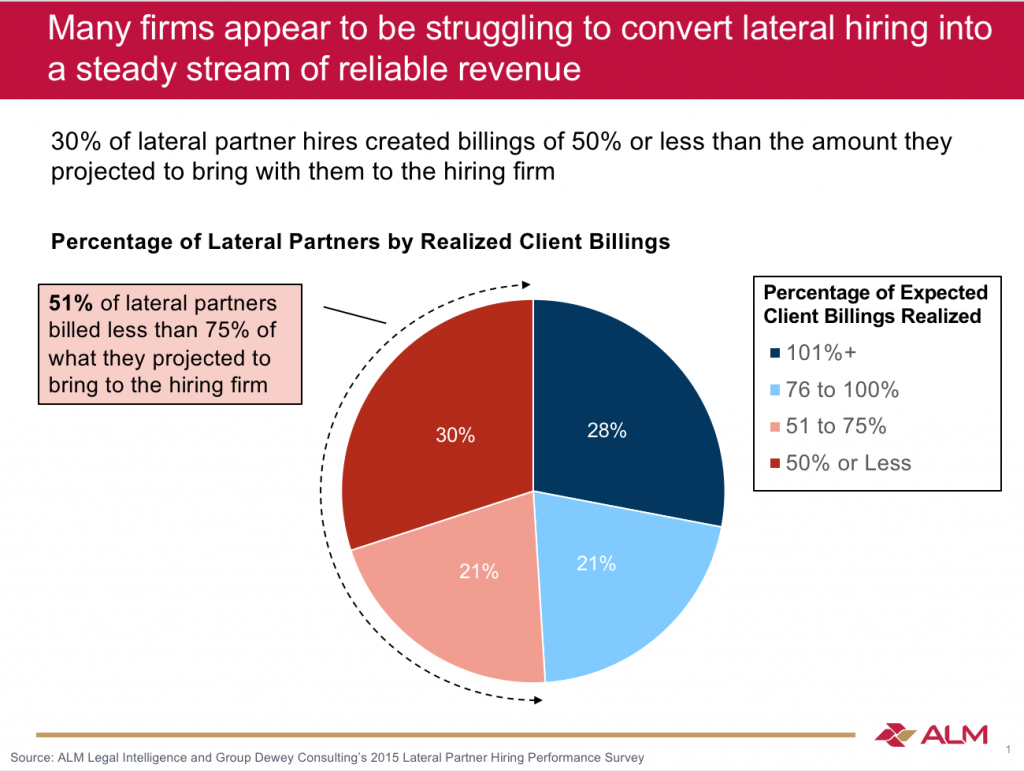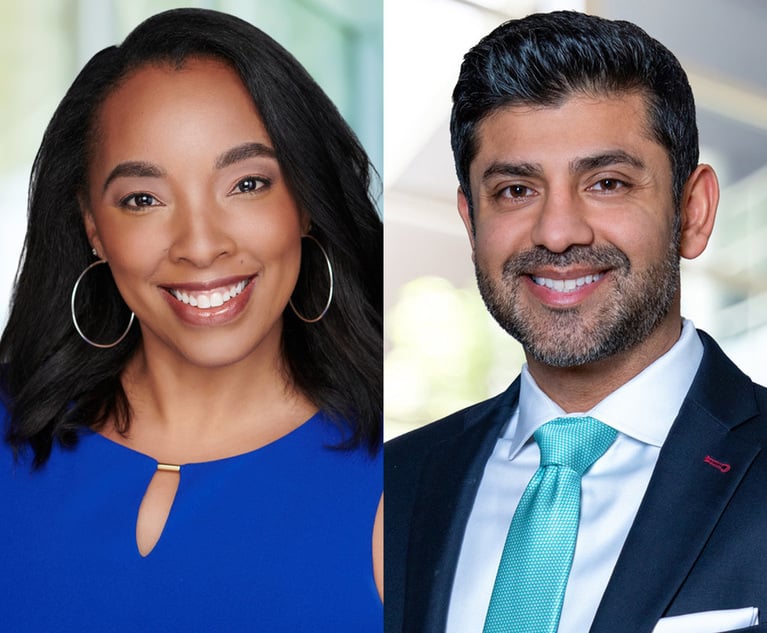Integrating Lateral Hires: The Key to Retention and Productivity
Law firms' current lateral hiring practices are failing. Here's what their leaders can do about it.
February 11, 2019 at 12:12 PM
15 minute read

While law firms fiercely compete to recruit and hire the industry's best and brightest, the strategy of accumulating stars without a strategic plan and simply hoping for the best tends to fail. Despite the staggering amount of money spent on talent (nearly 70 percent of a firm's total expenses), many lateral hires fail to meet firm expectations and are out the door within three to five years. The secret to productive lateral hiring success lies initially in the pre-hiring strategy and later in the integration and retention of these newly acquired thoroughbreds. Yet, firms continuously misallocate their resources by spending too much time on recruiting and wooing prospective lateral hires rather than integrating them after they join—a misstep that leads to serious profit loss down the road.
What we've found—based on a decade of empirical data across many law and other kinds of professional firms—is that lateral hires who engage in collaborative client and internal work with their new colleagues are significantly more likely to stay with the firm longer, to hit or exceed their targets, and to prosper professionally. Interactive, client-focused work that often spans practice groups is how we define “smart collaboration.” Smart collaboration allows a team of talented problem-solvers with specialized legal expertise to integrate their collective knowledge to tackle and solve their clients' thorniest problems, in ways that no single individual could accomplish—no matter how clever or hardworking.
How exactly does smart collaboration help laterals to thrive? Smart collaboration gives new hires the opportunity to share their valuable expertise, promote their reputation and foster their colleagues' interpersonal and competence trust early on at their new firm. Further, collaboration helps to bring lateral hires up to speed with the way the firm operates—especially the unwritten rules and cultural expectations. Through these experiences, new joiners become part of the fabric of the firm, finding not only commercial and professional success, but also more meaningful and deeper relationships. In short, smart collaboration—combined with clear planning and proper follow-through—can help lateral hires to acculturate and thrive. The trick, of course, is making sure that your firm is set up to foster this kind of lateral-incumbent collaboration.
This article explores how firms' current lateral hiring practices are failing and what their leaders can do about it. We'll break down lateral hiring into three stages, provide guidance on how to assess your own firm's process, and finally offer our top recommendations that yield the biggest return on your efforts.
Most Lateral Hiring is Failing
Most firms recognize—and research confirms—that it takes three to five years for a lateral hire just to reach the level of performance they displayed in their old firm, let alone to become even more productive. Only 28 percent of laterals actually hit their expected client billings in their first year. Further, most laterally hired lawyers who are struggling to become productive in their new firm simply do not stick it out for more than a few years at best.

Firms that fix and optimize their talent systems will enjoy significant long-term benefits: increased revenue, stronger and more diverse teams, a tight-knit culture and a growing network that creates unforeseen and welcome business opportunities; others risk a downward spiral of lower profits, then loss of exceptional talent, which further reduces profitability.
Speed Is Key
Increased mobility has fostered the emergence of a free-agent mentality, so firms need to move quickly to integrate laterals so they don't jump ship for a competitor. For lateral partners, our analysis shows that they must be sufficiently integrated with incumbent partners and clients within the first 18 months, if not sooner, to succeed at the firm. Specifically, two things need to happen in that short time: Lateral partners need to have had the opportunity to work on at least a couple of the firm's incumbent clients (on pitches, if not actual projects), and they need a couple of incumbent partners to help on the client work they generate (either clients they have imported or new clients). Firms need to encourage laterals to collaborate both ways: receive and give referrals on substantive client work. If either is missing, new lateral partners are at a higher risk of leaving; if neither happens, they are very likely to leave the firm by their three-year anniversary.
Retaining Partners
Firms need a well-constructed plan and a relentless focus on execution and clear accountability processes if they expect to help laterals achieve two-way collaboration quickly and efficiently. Many law firms claim to have a plan, but then rely on opportunistic approaches. As one law firm CEO put it, however, “'Opportunistic' is a euphemism for no plan.”
Instead, law firms must properly hire and integrate lateral talent to ensure that the lateral becomes embedded on cross-disciplinary teams—that is, to ensure collaboration. Firms that implement the strategic processes outlined in this article will increase the chances of productive lateral hiring and reap the myriad benefits of retaining their sought-after talent.
What Firms Can Do
Law firms spend buckets of money on lateral hiring, but so much of that effort is misguided. You can better your odds with laterals by following these critical action steps, which fall into three stages: preparing to hire; recruiting and interviewing; and integration.
Firms currently spend too much time recruiting and too little time preparing for and integrating lateral hires. By redirecting time and resources more evenly across the board, firms have a better shot at hiring more productive laterals in the long run.
Stage 1: Planning to Hire
Productive lateral hiring has the power to grow revenues, increase innovation and build an inclusive firm culture. Several best practices can help firms strategically prepare for their hiring needs before recruitment:
- Connect your talent plan to the firm's strategic plan;
- Update analysis of future needs;
- Define the expertise needed and think creatively about who is best placed to meet objectives;
- Consider internal laterals before looking for external candidates;
- Create a data-driven business plan;
- Run analyses to track pockets of churn and burn;
- Define the role and articulate the required capabilities;
- Develop the talent pool;
- Allocate the support necessary for success.
Our top recommendations for Stage 1 include:
Connect your talent plan to the firm's strategic plan. Establishing a strategy requires firms to make tough choices about where to invest and where to refrain from playing. Avoid a dilutive “best at everything” approach. Instead, decide on three to five of the most important goals connected to talent strategy and firm objectives. One chief talent officer at a global law firm put it this way: “We're morphing into hiring more strategically and connecting new hires to the broader goals and needs of the organization, both in the immediate time period as well as a year, two years, three years down the road. But I still think we just aren't as sophisticated as some or our corporate clients are.”
Create a data-driven business plan. Employ a robust, data-based analysis that forms the business case for each lateral hire. Jennifer Scalzi at Calibrate Legal explained, “It's the leader's job to bring data—however imperfect and incomplete—to planning decisions. You need to look deeply at data from your clients and your firm to build insights and ultimately generate the best business case for investment.” Many firms believe that they already have such a system in place, but most of the plans we have reviewed are arguments, not analyses. Engage your financial and business development experts to collect and dissect both internal and market data to calculate anticipated return on investment for each proposed candidate. Consider factors such as expanding business opportunities, new offices, partner turnover and newly developed (or growing) practice or sector-focused groups. Sometimes an internal resource is the best (and easiest) option.
Run analyses to track pockets of churn and burn. Gather and review your lateral hiring data from the last five years or so, with a specific focus on who pushed for or sponsored the request, and how well each of those laterals fared once hired. You may discover a strong correlation between certain partners' or practices' attempts and success rates or pockets of churn and burn. Generally, offending groups fail to strategically consider their hiring requests, use the wrong hiring criteria or lack the proper means to integrate laterals once they arrive. Gaining a full understanding of exactly what is broken helps a firm to pinpoint a sustainable, practical and long-term fix.
Stage 2: Recruiting and Interviewing
Despite the enormous amount of time and money law firms spend on recruitment, their efforts are often short-sighted and ineffective for future growth. One CMO at a global law firm explained why: “It's easier for [firms] to spend time in the middle section, because that's kind of outsourced. They're working with a recruiter. They're meeting people. It's not taking a ton of brainpower. But building consensus and really figuring out what the job description is, it's tough.” Devising a comprehensive recruitment strategy can feel cumbersome to achieve at the onset. To help you get started, here are our recommended best practices that firms typically overlook during the recruiting and interviewing process:
- Search for capabilities over credentials;
- Evaluate candidates across four key capabilities;
- Identify and train people to conduct behavioral-based interviews;
- Determine key qualifications and assign scores to each;
- Use the interview data to debrief and make decisions.
Our top recommendations for this stage:
Evaluate candidates across four key capabilities. Hiring is greatly improved when organizations perform multiple interviews to triangulate on the following attributes: '
- Technical and leadership competence. The technical competencies required for each position will vary based not only on the disciplinary expertise required for work product, but also on the managerial and leadership demands related to the role. Since leadership of different practice groups or business units may be at odds about the exact set of desired technical competencies required, the interview guidelines needed to be high level to combat partners from falling back on unstructured and unhelpful “Would I want to be friends with this person outside of work?” interviews.
- Collaborative capacity versus ability to develop, work with, and leverage networks. Collaborative capacity refers to a candidate's suitability to become the kind of contributor who can truly leverage your firm's full set of expertise in order to solve both the firm's and its clients' most complex, high-value problems.
- Cultural fit. This is where law firms place the most emphasis, but the downside is that you hire only “Mini-Me” types.
- Firm experience. In general, lateral partner hires who move to higher-profit firms are more successful than those who move to lower-profit firms. For business professionals, look for those that possess a demonstrated ability to operate in a conservative environment and ability to understand the law firm client and tailor best practices to fit the firm.
Stage 3: Integration
Firms that analyze their own cultures, pinpoint desirable attributes of existing players and hire for those attributes will best assimilate and retain talent. That edge is a true competitive advantage in today's hot labor market. In addition to the lateral hire's ability to hit the ground running and higher likelihood of staying with the firm with proper integration, firms have a better shot of delivering the highest value work for their clients, which is the job that they were hired to do. Among the steps required to for effective integration are:
- Make laterals' experience meaningful from Day 1 and start even before they officially join;
- Shape processes around new hires' strengths and firm culture;
- Assign a peer mentor;
- Assist new joiners in building their networks;
- Hold new joiners, the hiring partner and peers accountable for success;
- Continuously audit and revamp the lateral integration process.
Our top recommendations are:
Hold new joiners, the hiring partner and peers accountable for success. Creating an agreed-upon business plan with projected ROIs—and buy-in from all parties—is critical. Law firms are notoriously bad at holding their lawyers and professionals directly accountable. Instead, firms tend to rely on a vague notion of reputational accountability—that is, people will perform to maintain their reputations, even if no one is monitoring them. To improve lateral success and hold stakeholders accountable, firms must do the following:
- Make it clear to hiring groups that their ability to hire future laterals will depend on how successfully they integrate each newcomer. You might not be able to measure immediate financial results, but you can track activity. When partners do create these opportunities, celebrate them across the firm. Recognition for good behavior not only encourages more partners to engage in it, but also helps to spread the newcomer's reputation as a collaborative, value-adding asset within the firm.
- Set expectations that the integration process will be three to four years, and create goals for what is expected to happen in each of those years.
- Check in with the lateral hire with respect to the hire's business plan, individual development plan and other agreed-upon metrics at three-month, six-month, nine-month and one-year intervals to identify and remedy issues before they escalate.
Continuously audit and revamp the lateral integration process. An audit helps to measure the success of your current efforts and also provides the justification for additional resources. Reach out to lateral hires from the last five years or so and ask them about their integration experience with the firm. Questions should target the laterals' early-stage integration in client work, inclusion in value-adding activities, usefulness of orientation training and ease of transferring clients. Joe Macrae, CEO at Mlegal recruiting firm, observed, “Many senior laterals say that their former firm appeared completely disinterested in inquiring as to why a key partner would chose to leave. I suggest that firms could benefit from conducting exit interviews not to try and 'turn' the partner (a quite separate exercise) but to get valuable feedback on what motivated the decision to uproot. Very few partners take that decision lightly.” Finally, probe for other friction points, which often reveal valuable insights and the opportunity to make small, tangible changes tied to larger, systemic problems. After performing a thorough audit, take a step back and question not only current processes, but underlying assumptions.
Lateral Hiring Done Right
In today's competitive marketplace, your firm's ability to attract, integrate and ultimately retain lateral hires is critical. Law firms, in-house legal departments, late-stage startups, premier consulting, financial and accounting firms—they are all circling and closing in to steal your best talent. You need that talent to maintain your firm's portfolio of cross-disciplinary expertise to solve both client problems and your firm's own business challenges. Smart collaboration isn't optional; it's a business imperative for the strategic growth, profitability, and sustainability of a firm.
So how do you retain your expensive lateral hires, ensure their productivity and ultimately enhance your firm's viability? Analyze your current efforts using the three-stage process for successful lateral hiring outlined in this article and then recalibrate and build your program to incorporate the best practices that align with your firm's strategic objectives. The firms that get it right—that is, those that discover the talent mix that is aligned with the overall firm strategy and develop an effective plan to locate, lure and lock in that talent—will emerge the victors.
Heidi K. Gardner is a distinguished fellow at Harvard Law School's Center on the Legal Profession. She teaches leadership and collaboration in Harvard Law School's Executive Education programs for law firm partners. Her new book is ““Smart Collaboration for Lateral Hiring,” published by Globe Law & Business.
This content has been archived. It is available through our partners, LexisNexis® and Bloomberg Law.
To view this content, please continue to their sites.
Not a Lexis Subscriber?
Subscribe Now
Not a Bloomberg Law Subscriber?
Subscribe Now
NOT FOR REPRINT
© 2025 ALM Global, LLC, All Rights Reserved. Request academic re-use from www.copyright.com. All other uses, submit a request to [email protected]. For more information visit Asset & Logo Licensing.
You Might Like
View All
Government Attorneys Face Reassignment, Rescinded Job Offers in First Days of Trump Administration
4 minute read


Energy Lawyers Field Client Questions as Trump Issues Executive Orders on Industry Funding, Oversight
6 minute readTrending Stories
- 1We the People?
- 2New York-Based Skadden Team Joins White & Case Group in Mexico City for Citigroup Demerger
- 3No Two Wildfires Alike: Lawyers Take Different Legal Strategies in California
- 4Poop-Themed Dog Toy OK as Parody, but Still Tarnished Jack Daniel’s Brand, Court Says
- 5Meet the New President of NY's Association of Trial Court Jurists
Who Got The Work
J. Brugh Lower of Gibbons has entered an appearance for industrial equipment supplier Devco Corporation in a pending trademark infringement lawsuit. The suit, accusing the defendant of selling knock-off Graco products, was filed Dec. 18 in New Jersey District Court by Rivkin Radler on behalf of Graco Inc. and Graco Minnesota. The case, assigned to U.S. District Judge Zahid N. Quraishi, is 3:24-cv-11294, Graco Inc. et al v. Devco Corporation.
Who Got The Work
Rebecca Maller-Stein and Kent A. Yalowitz of Arnold & Porter Kaye Scholer have entered their appearances for Hanaco Venture Capital and its executives, Lior Prosor and David Frankel, in a pending securities lawsuit. The action, filed on Dec. 24 in New York Southern District Court by Zell, Aron & Co. on behalf of Goldeneye Advisors, accuses the defendants of negligently and fraudulently managing the plaintiff's $1 million investment. The case, assigned to U.S. District Judge Vernon S. Broderick, is 1:24-cv-09918, Goldeneye Advisors, LLC v. Hanaco Venture Capital, Ltd. et al.
Who Got The Work
Attorneys from A&O Shearman has stepped in as defense counsel for Toronto-Dominion Bank and other defendants in a pending securities class action. The suit, filed Dec. 11 in New York Southern District Court by Bleichmar Fonti & Auld, accuses the defendants of concealing the bank's 'pervasive' deficiencies in regards to its compliance with the Bank Secrecy Act and the quality of its anti-money laundering controls. The case, assigned to U.S. District Judge Arun Subramanian, is 1:24-cv-09445, Gonzalez v. The Toronto-Dominion Bank et al.
Who Got The Work
Crown Castle International, a Pennsylvania company providing shared communications infrastructure, has turned to Luke D. Wolf of Gordon Rees Scully Mansukhani to fend off a pending breach-of-contract lawsuit. The court action, filed Nov. 25 in Michigan Eastern District Court by Hooper Hathaway PC on behalf of The Town Residences LLC, accuses Crown Castle of failing to transfer approximately $30,000 in utility payments from T-Mobile in breach of a roof-top lease and assignment agreement. The case, assigned to U.S. District Judge Susan K. Declercq, is 2:24-cv-13131, The Town Residences LLC v. T-Mobile US, Inc. et al.
Who Got The Work
Wilfred P. Coronato and Daniel M. Schwartz of McCarter & English have stepped in as defense counsel to Electrolux Home Products Inc. in a pending product liability lawsuit. The court action, filed Nov. 26 in New York Eastern District Court by Poulos Lopiccolo PC and Nagel Rice LLP on behalf of David Stern, alleges that the defendant's refrigerators’ drawers and shelving repeatedly break and fall apart within months after purchase. The case, assigned to U.S. District Judge Joan M. Azrack, is 2:24-cv-08204, Stern v. Electrolux Home Products, Inc.
Featured Firms
Law Offices of Gary Martin Hays & Associates, P.C.
(470) 294-1674
Law Offices of Mark E. Salomone
(857) 444-6468
Smith & Hassler
(713) 739-1250










